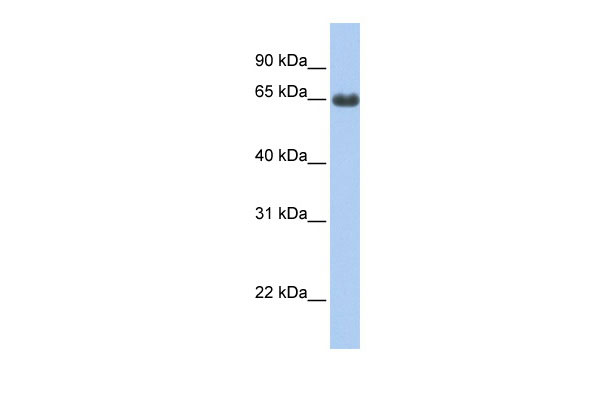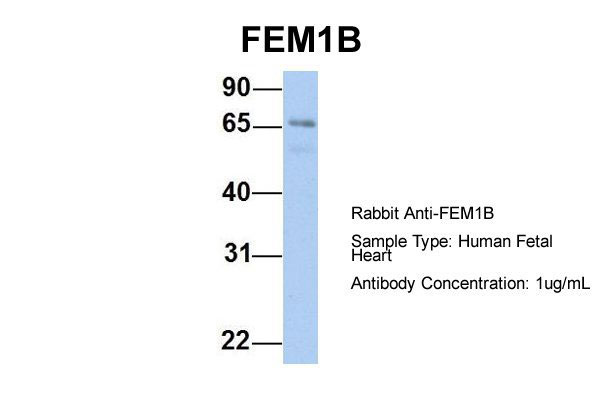FEM1B antibody - C-terminal region
Rabbit Polyclonal Antibody
- 产品详情
- 实验流程
Application
| WB |
|---|---|
| Primary Accession | Q9UK73 |
| Other Accession | NM_015322, NP_056137 |
| Reactivity | Human, Mouse, Rat, Rabbit, Dog, Guinea Pig, Horse, Bovine |
| Predicted | Human, Mouse, Rat, Rabbit, Pig, Dog, Horse, Bovine |
| Host | Rabbit |
| Clonality | Polyclonal |
| Calculated MW | 70264 Da |
| Gene ID | 10116 |
|---|---|
| Alias Symbol | DKFZp451E0710, FIAA, F1A-ALPHA |
| Other Names | Protein fem-1 homolog B, FEM1b, FEM1-beta, Fem-1-like death receptor-binding protein alpha, Fem-1-like in apoptotic pathway protein alpha, F1A-alpha, FEM1B, F1AA, KIAA0396 |
| Format | Liquid. Purified antibody supplied in 1x PBS buffer with 0.09% (w/v) sodium azide and 2% sucrose. |
| Reconstitution & Storage | Add 50 ul of distilled water. Final anti-FEM1B antibody concentration is 1 mg/ml in PBS buffer with 2% sucrose. For longer periods of storage, store at 20°C. Avoid repeat freeze-thaw cycles. |
| Precautions | FEM1B antibody - C-terminal region is for research use only and not for use in diagnostic or therapeutic procedures. |
| Name | FEM1B {ECO:0000303|PubMed:10623617, ECO:0000312|HGNC:HGNC:3649} |
|---|---|
| Function | Substrate-recognition component of a Cul2-RING (CRL2) E3 ubiquitin-protein ligase complex of the DesCEND (destruction via C-end degrons) pathway, which recognizes a C-degron located at the extreme C terminus of target proteins, leading to their ubiquitination and degradation (PubMed:29779948, PubMed:33398168, PubMed:33398170). The C- degron recognized by the DesCEND pathway is usually a motif of less than ten residues and can be present in full-length proteins, truncated proteins or proteolytically cleaved forms (PubMed:29779948, PubMed:33398168, PubMed:33398170). The CRL2(FEM1B) complex specifically recognizes proteins ending with -Gly-Leu-Asp-Arg, such as CDK5R1, leading to their ubiquitination and degradation (PubMed:33398168, PubMed:33398170). Also acts as a regulator of the reductive stress response by mediating ubiquitination of reduced FNIP1: in response to reductive stress, the CRL2(FEM1B) complex specifically recognizes a conserved Cys degron in FNIP1 when this degron is reduced, leading to FNIP1 degradation and subsequent activation of mitochondria to recalibrate reactive oxygen species (ROS) (By similarity). Mechanistically, recognizes and binds reduced FNIP1 through two interface zinc ions, which act as a molecular glue that recruit reduced FNIP1 to FEM1B (By similarity). Promotes ubiquitination of GLI1, suppressing GLI1 transcriptional activator activity (PubMed:24076122). Promotes ubiquitination and degradation of ANKRD37 (By similarity). Promotes ubiquitination and degradation of SLBP (PubMed:28118078). Involved in apoptosis by acting as a death receptor-associated protein that mediates apoptosis (PubMed:10542291). Also involved in glucose homeostasis in pancreatic islet (By similarity). May also act as an adapter/mediator in replication stress-induced signaling that leads to the activation of CHEK1 (PubMed:19330022). |
| Cellular Location | Cytoplasm. Nucleus Note=In the nucleus, the protein level increased slightly after camptothecin (CPT) treatment (PubMed:19330022). Associated with chromatin (PubMed:19330022). |
| Tissue Location | Widely expressed (PubMed:10542291). Highly expressed in testis (PubMed:10542291). Weakly expressed in other tissues (PubMed:10542291). |
Research Areas
For Research Use Only. Not For Use In Diagnostic Procedures.
Application Protocols
Provided below are standard protocols that you may find useful for product applications.
REFERENCES
Chan S.-L.,et al.J. Biol. Chem. 274:32461-32468(1999).
Ventura-Holman T.,et al.Biochem. Biophys. Res. Commun. 267:317-320(2000).
Ishikawa K.,et al.DNA Res. 4:307-313(1997).
Nakajima D.,et al.DNA Res. 9:99-106(2002).
Ota T.,et al.Nat. Genet. 36:40-45(2004).
终于等到您。ABCEPTA(百远生物)抗体产品。
点击下方“我要评价 ”按钮提交您的反馈信息,您的反馈和评价是我们最宝贵的财富之一,
我们将在1-3个工作日内处理您的反馈信息。
如有疑问,联系:0512-88856768 tech-china@abcepta.com.























 癌症的基本特征包括细胞增殖、血管生成、迁移、凋亡逃避机制和细胞永生等。找到癌症发生过程中这些通路的关键标记物和对应的抗体用于检测至关重要。
癌症的基本特征包括细胞增殖、血管生成、迁移、凋亡逃避机制和细胞永生等。找到癌症发生过程中这些通路的关键标记物和对应的抗体用于检测至关重要。 为您推荐一个泛素化位点预测神器——泛素化分析工具,可以为您的蛋白的泛素化位点作出预测和评分。
为您推荐一个泛素化位点预测神器——泛素化分析工具,可以为您的蛋白的泛素化位点作出预测和评分。 细胞自噬受体图形绘图工具为你的蛋白的细胞受体结合位点作出预测和评分,识别结合到自噬通路中的蛋白是非常重要的,便于让我们理解自噬在正常生理、病理过程中的作用,如发育、细胞分化、神经退化性疾病、压力条件下、感染和癌症。
细胞自噬受体图形绘图工具为你的蛋白的细胞受体结合位点作出预测和评分,识别结合到自噬通路中的蛋白是非常重要的,便于让我们理解自噬在正常生理、病理过程中的作用,如发育、细胞分化、神经退化性疾病、压力条件下、感染和癌症。







